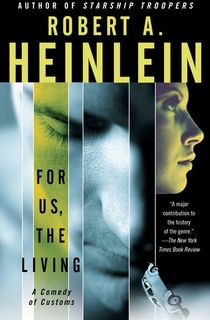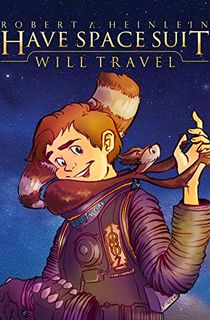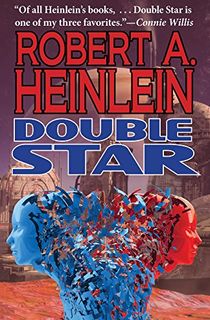Often called the “dean of science fiction writers,” Robert Heinlein was one of the first novelists of the form to break into the mainstream, with early publications in magazines like The Saturday Evening Post. He is also, along with Isaac Asimov and Arthur C. Clarke, considered one of the “Big Three” when it comes to English-language science fiction of the so-called Golden Age of sci-fi.
Among his many contributions to the genre, Heinlein was one of the first science fiction writers to heavily prioritize scientific accuracy—at least, as it was understood at the time—and, as such, is a major influence on modern hard science fiction subgenres. His work also proved influential in a number of other ways, and elements of Heinlein’s writing can be found in everything from modern-day scientific thought to Warhammer 40,000.
Winner of several Hugo Awards—and many more Retro Hugos, awarded posthumously in recognition of his contributions to the field—Heinlein was also a naval officer and an aeronautical engineer, who often bragged about spending days working out the mathematical underpinnings of even the smallest details in his stories. Like many science fiction authors at the time, his political and social views were a complex stew of seemingly-contradictory impulses that evolved considerably over the course of his life, though his stories often favored individualism and even libertarian ideals.
With a career that spans nearly half-a-century and over thirty novels, there’s plenty of Heinlein out there to choose from, even though he passed away as an octogenarian more than thirty years ago. So, if you’re new to Heinlein, or have had just a taste and want to know where to go next, here are some of the most essential, classic Robert Heinlein books from his prolific and genre-defining career.
Heinlein's Classic Sci-Fi Books

Starship Troopers
First published in the Magazine of Fantasy & Science Fiction in 1959, Starship Troopers may be Heinlein’s best-known and most widely-read work.
Written as a protest against President Dwight Eisenhower’s suspension of U.S. nuclear weapons testing during the Cold War, Starship Troopers has been denounced as fascist propaganda by many in the years since.
Nonetheless, it won a Hugo for Best Novel when it was first released, and has had an enormous impact on science fiction, with many citing it as the progenitor of military sci-fi. It also marked a major turning point in Heinlein’s career, as he set aside the novels for younger readers that he had frequently published before to pursue stories aimed more at adults. The book has been adapted to film by Paul Verhoeven, who turned its pro-militarism message on its head through satire.

For Us, the Living
Written in 1938, For Us, the Living wasn't published until 2003 after its manuscript went missing for decades. In 1939, Perry Nelson is driving along the palisades when an accident leads to him swerving off-road and hitting his head. When he wakes up, he sees a girl in a green bathing suit, and the landscape has changed from a sunny beach to snowy mountains.
A woman named Diana saves him and informs Perry that the date is January 7, 2086. So much has changed in the interim 150 years, and Perry's knowledge of the past makes him unique to his new contemporaries. This future seems bright, but what is brimming below the surface?

Friday
Friday is a secret courier in Earth of the near-future who is employed by a mysterious man known to her only as "Boss." America has been divided into dozens of independent states and each of them is wildly different from one another, with their own laws and norms that often veer into the totally bizarre.
Friday's latest job takes her across the disunited states and the rest of the world, and each place she journeys to poses a whole new set of worries.

Stranger in a Strange Land
If Starship Troopers is not Heinlein’s best-known novel, then that title must go to Stranger in a Strange Land, the first novel published after Starship Troopers, at the beginning of what is known as Heinlein’s “middle period.”
The first science fiction novel on the New York Times Bestseller list, Stranger in a Strange Land has been named by the Library of Congress as one of the “88 Books that Shaped America,” alongside such titles as The Wizard of Oz, The Great Gatsby, and The Sound and the Fury.
Originally published in 1961, the novel tells the story of Valentine Michael Smith, a human who was raised entirely by Martians. Returning to Earth, he becomes the eponymous “stranger in a strange land” as he tries to understand human customs, allowing the author a far-ranging commentary on everything from government to sexuality to religion.

The Moon Is a Harsh Mistress
A nominee for the Nebula and winner of the 1967 Hugo Award for Best Novel, The Moon is a Harsh Mistress was first published in 1966, near the end of Heinlein’s “middle period.”
The book, which tells of the revolution of a lunar penal colony against an absentee Earth government, explores many of the author’s libertarian ideals, while also telling a genre-defining tale that involves political upheaval, thinking supercomputers, electromagnetic catapults capable of flinging rocks toward Earth with the power of an atom bomb, and lots more.
It has also been credited as the originator of the phrase, “There ain’t no such thing as a free lunch" (or, TANSAAFL).

Variable Star
Joel Johnston has fallen in love with Jinny Hamilton, but as a broke composer, he lacks the funds to give her the life she deserves. Fortunately for here, she's secretly Jinny Conrad, the granddaughter of Richard Conrad, the wealthiest man in the solar system. She wanted to make sure Joel loved her for who she was, not her money, but the shock of the reveal sends him running off with cold feet.
After a hardcore bender, he ends up colony ship heading out into space. Before he can fix his mistakes, things get far worse. Now, Joel has to save the entirety of humanity from a cosmic disaster that could wipe out half the galaxy.
As if his romance problems weren't bad enough.

The Puppet Masters
Originally published in 1951, The Puppet Masters is one of the best-known (and best-regarded) of Heinlein’s early novels.
Its groundbreaking story follows a group of slug-like aliens who arrive on Earth in flying saucers and proceed to take over humans by attaching themselves to their nervous systems and directing them around like puppets. This convention that has since reappeared, in various forms, in countless other tales, including a 1994 film adaptation starring Donald Sutherland.
The novel is also notable for featuring an extremely representative triptych of some of Heinlein’s most often-reused character archetypes, including the ruggedly individualistic protagonist, his hard-nosed (and red-haired) love interest, and the wise but cantankerous older gentleman.

The Year of the Jackpot
This distinctly Heinleinian novella was the cover story of the March 1952 issue of Galaxy Science Fiction. It centers around a statistician who finds love at what just might be the end of the world.
Following Heinlein’s tendency to write about subjects which were, at the time, considered hard science, the story deals in concepts like Kondratiev waves, the idea that human social behavior—including politics, religion, social mores, and the economy—follow phases that happen in cycles.

Have Space Suit - Will Travel (Heinlein's Juveniles Book 12)
In the near future, Earth has established lunar bases, and teenage wannabe explorer Clifford "Kip" Russell is determined to visit them. The ticket price is well beyond his means, sadly, and his attempts to raise money in a jingle-writing contest didn't work. But he did win a used space suit and decides to go for a quick jaunt in it. He answers a distress radio call from a child genius named Peewee and ends up being kidnapped. At least now he’ll get to go to the Moon, but first he must save the day.

Time Enough for Love
Written near the end of Heinlein’s “middle period,” Time Enough for Love introduces many of the elements that would appear in the author’s final works.
Protagonist Lazarus Long was originally introduced all the way back in the novel Methusalah’s Children, first serialized in 1941, but didn’t make his reappearance until this 1973 Hugo, Nebula, and Locus-nominated novel.
The beneficiary of a complex breeding experiment intended to increase the longevity of its offspring, Long enjoys an extremely lengthy lifespan; one that, at the beginning of Time Enough for Love, he has decided is no longer worth living. Long would later reappear in most of Heinlein’s final works, including The Number of the Beast and The Cat Who Walks Through Walls.

Double Star
Lorenzo Smythe is a struggling actor who's more likely to be found in a bar drowning his sorrows than at work on the stage or screen. After his latest binge, he finds himself talking to a space pilot about his latest mission, but then he's suddenly kidnapped and sent to Mars.
Now, he's found himself agreeing to the most difficult role of his career: impersonating an important politician who's been kidnapped and whose presence is necessary for peace talks with the Martian race. If they don't pull this off, all-out war could break out between their planets. Smythe needs to put in the performance of his life.

Methuselah's Children
After the fall of the American Ayatollahs, the United States of America has at last become a nation with Liberty and Justice for All. Humans have regained their rights and freedoms, and they're ready for a period of peace and tranquillity after so many years of bloodshed. But they will always want more.
The Masquerade is a secret society dedicated to prolonging human life. Its members have greatly increased their life expectancy but want to achieve immortality through selecting breeding. With the promise of endless life on the line, it’s no wonder there are so many desperate to reveal the secrets of the Masquerade.

The Door into Summer
Electronics engineer Dan Davis has spent most of his life working on the creation he hopes will define his career: a household robot designed to do all of the mundane daily activities and free up humans for their true pleasures. But then he was tricked by an unscrupulous greedy business partner and conniving fiancé into spending thirty years in suspended animation just before he could cash in on his success.
They never imagined what would happen when Dan woke up. Now, he's the modern-day Rip Van Winkle and he's mastered the magic of time travel. He will get his revenge and his enemies won't be spared.










